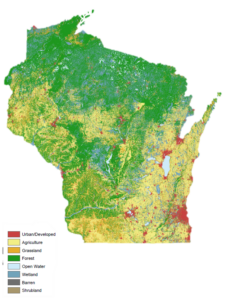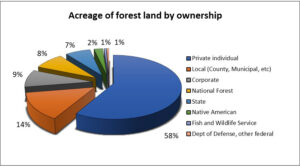By Collin Buntrock, DNR Forest Products Team Leader and Brian Anderson, DNR Forest Inventory Analyst
Forests are an essential part of Wisconsin’s past and present. Wisconsin’s forests cover over 40% of the total land area, encompassing nearly 17 million acres. Since the cutover of the 19th and early 20th centuries, Wisconsin’s forests have been expanding consistently in acreage, volume and annual growth rate. Those trends largely continue today.
The U.S. Forest Service’s Forest Inventory and Analysis (FIA) program has taken inventories of Wisconsin’s forests — and the nation’s forests as a whole — since the 1930s. This inventory program provides critical information on Wisconsin’s forests to inform how we manage, utilize, and conserve our forestland. The U.S. Forest Service administered this annual program in close cooperation with the Wisconsin Department of Natural Resources’ (DNR) Division of Forestry.
Since 1968, Wisconsin has provided funding to intensify the inventory by doubling the number of permanent plots from which data are collected. This offers more reliable data on areas smaller than on a statewide basis. It is critical in a landscape like Wisconsin, given the considerable heterogeneity and great number of important forest types.
The data collected through the FIA program can be used in a variety of ways. Uses include: decisions around forest management and planning by a wide array of ownerships; assessing the sustainability of forest management practices like harvest volumes over time; taking stock of trends in forest health such as mortality related to Emerald Ash Borer and oak wilt; and evaluating wildlife habitat conditions at landscape scales such as ruffed grouse habitat. Combined with other data sources, analyses on forest health, harvesting, and species compositional changes provide essential feedback on how we manage our forests and changes we should note.
Forest Acreage And Ownership

Figure 1. Wisconsin land cover (2018)
Wisconsin’s forests are located primarily in the state’s northern and central areas (Figure 1). Aspen-birch, maple-basswood and spruce-fir are predominantly northern forest types. Pine and oak-pine predominate in the sandy soils of central, northwest and northeast Wisconsin. Furthermore, the Oak-hickory forest type occurs mainly in the southwest and central parts of the state. Bottomland hardwoods are distributed throughout the state in low-lying areas.
Wisconsin’s forests are owned by a wide variety of public and private entities. An estimated 67 percent of forest land in Wisconsin is privately owned. The majority of the estimated 11.5 million acres are owned by non-industrial family forest owners (Figure 2). Corporations own an estimated 1.5 million acres and other private owners, including conservation organizations and unincorporated clubs and partnerships, own an estimated 0.3 million acres.
Conversely, public entities hold 5.2 million acres of forest land in the state. Local government agencies, largely the 30 county forests, own and manage an estimated 2.4 million acres of forest land in Wisconsin. The federal government manages approximately 1.6 million acres of forest land, much of this in the Chequamegon-Nicolet National Forest. The State of Wisconsin manages another 1.2 million acres. Native American tribes own 0.4 million acres of forest land, which are either managed by the tribes or by the federal government in trust on behalf of the tribal community members.

Figure 2. Forest and ownership in Wisconsin (2018)
Forest Volume, Growth And Harvest Removals
Wisconsin has over 22 billion cubic feet of growing stock volume in trees over 5 inches in diameter, increasing 43% since 1983. To put this into perspective, this volume is approximately equal to the volume of Lake Mendota in Madison, Wisconsin or the volume of water that discharges from the Wisconsin River over 22 days. The volume of white pine has more than tripled and the volume of red maple and red pine has doubled since 1983. Ash, white oaks, hemlock and sugar maple volume has also increased by over 50%. Of all species, jack pine and paper birch have undergone the largest volume decrease in the last two decades. Balsam fir, aspen and yellow birch have also declined.
Forest growth continues to nearly double the volume of harvest removals each year. In 2018, the average annual net growth was 571 million cubic feet, while the removals from harvest and other factors was 295 million cubic feet. This surplus in annual volume (net growth minus removals) equates to extending one-foot cubes of wood in a chain around the earth’s equator twice. Total harvest removals in Wisconsin have steadily declined since 2003 (Figure 3), largely due to the Great Recession and mill closures and conversions.
Future Of Wisconsin’s Forests
Wisconsin’s forests are dynamic and will continue to change due to both natural and human-induced processes. The state’s forests continue to age, and certain early-successional species such as paper birch and jack pine have experienced long-term declines in

Figure 3. Average annual removal volumes in Wisconsin, 1983-2018
growth and volume. Furthermore, Wisconsin’s forests increasingly face threats from invasive plants, insects, diseases, climate change, fragmentation, and residential development. The health and stability of markets for harvested timber products also affect the potential for harvest removals, thereby providing an economic incentive for landowners to actively manage their lands and keep forests as forests.
Amid these challenges, the future holds promise for Wisconsin’s forests. The state’s forests continue to grow and provide Wisconsinites with countless benefits, from the products we use every day to clean air, clean water and many recreational opportunities. Continued monitoring of the type and scope of change in Wisconsin’s forests will be critical to successful management and enjoyment. The FIA program will ensure we have access to these trends well into the future.
